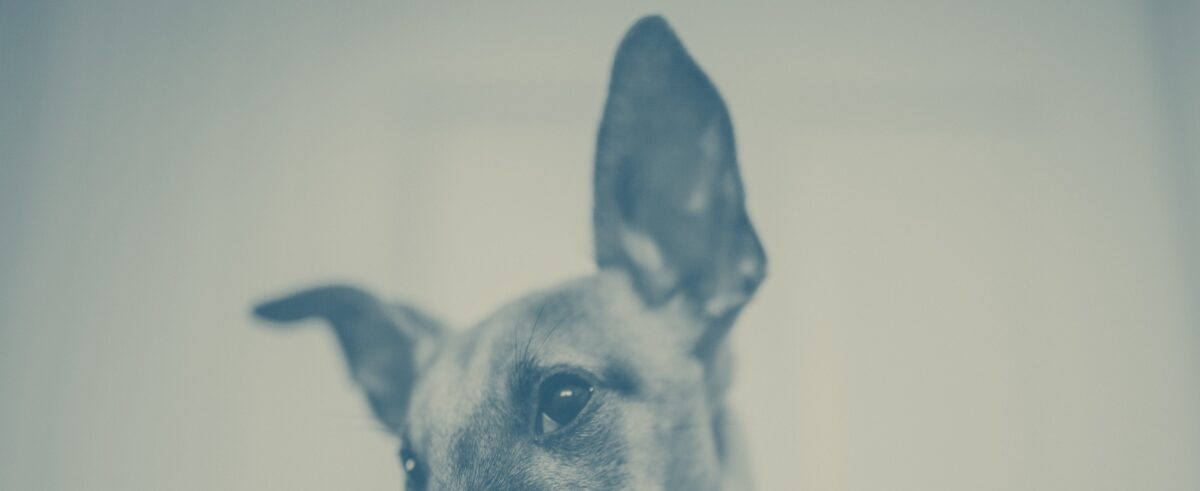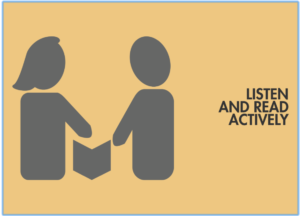Journalists can be portrayed as persistent, relentless questioners who hardly take the time to breathe before their next question, but that image doesn’t tell the whole story. What do journalists do when their questions are being answered? How do they prepare for a story to be published? They listen and read actively, Core Practice #5 at The UCWbL. For my presentation for WRD 395, the class all undergraduate peer writing tutors take their first quarter at the UCWbL, I researched this Core Practice in the context of journalism. But first, I want to address why this topic interested me.
As a journalism major, I was interested in how journalists listen during interviews. Though journalists both ask questions and listen to responses, most of the education and preparation for interviewing focuses on the questioning alone. Yet journalists ask questions to get answers, so listening should be of equal or greater weight than questioning. In line with this unbalanced focus in journalism education, the research I found also focuses more on questioning and less on listening. This may be because listening is harder to measure and more implicit than asking.
In my research, I looked at sources on TV journalists actively listening for cues to ask the next question, comparisons between oral history and journalism, listening and researching to ensure intrepid interviewing, and listening as the role of the public journalist.
Source #1: The News Interview
In The News Interview: Journalistic and Public Figures on the Air, Steven Clayman and John Heritage used conversation analysis to examine transcripts of broadcast news interviews, including those of famous interviewers like Dan Rather, Larry King, and Judy Woodruff. They found that interviewers and interviewees often collaborate on questioning and answering by taking turns and waiting to be cued by one another. According to Clayman and Heritage, during TV interviews “the interviewer must parse the unfolding answer, unit by unit, to determine where and when a new question can be appropriately asked” (114). This requires interviewers to analyze the answer in real time and listen actively in order to most effectively ask a follow-up question.
Source #2: Journalism and Oral History
Mark Feldstein, an oral historian, discusses the similarities and differences between oral historians and journalists when interviewing subjects. He argues that both professions are aimed at seeking the truth. However, oral historians are gentle question-askers and take more time with each of their subjects, whereas journalists are more direct and interview more sources, dedicating less time to each individual subject. He states, “While oral historians are often trained to not to be flustered by silence during an interview, journalists often abhor such a vacuum—whether they are print journalists operating under a tight deadline or live television interviewers for whom there is no greater sin than ‘dead’ airtime,” (Feldstein 13). He believes both occupations can learn from the other; oral historians can ask stronger questions, and journalists can take more time to conduct interviews.
Source #3: Conducting Successful Interviews
In “Conducting Successful Interviews: Tips for Intrepid Research,” Patrick Dilley talks about the importance of listening and reading actively in preparation for and during interviews. He discusses reading about the interviewee’s background as well as examining research in related fields when preparing questions. He says, “listening requires . . . active mental consideration of both the content (words) and context (emotions) of what is being said, and not being said,” something we talk directly about in peer tutoring situations (134).
Source #4: Public Listening
Albert W. Dzur studied public journalism as a type of reporting that facilitates a deliberative democracy – an open, discussion-based democracy that focuses on and is run by the everyday public. This model of journalism involves constantly checking with the audience to make sure material is relevant. He contends, “This public listening involves finding out what is of concern for a community and then reporting on how those concerns are or are not being met,” (Dzur 316).
How can we apply this to The Writing Center?
Like journalists, peer tutors conduct one-on-one sessions to discover solutions to a writer’s task and are expected to check in with their larger writing community. It can be difficult for tutors to figure out what questions the writer will be responsive to and worrying about this can sometimes prevent them from actually listening to a writer. However, doing what Feldstein suggests and taking time to listen can make the writer feel more comfortable and heard. It might be necessary to look for physical cues, content and context, but ultimately active listening and reading can allow for the writer and the tutor to be truly engaged.
Discover more from UCWbLing
Subscribe to get the latest posts sent to your email.


